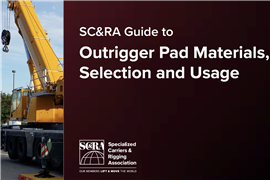A legacy of war: rebuilding Lebanon's infrastructure
10 April 2008
Lebanon's infrastructure was one of the targets in the crosshairs of Israel's military during its incursion into that country in 2006. This has left war-damaged structures requiring repair or removal and replacement. US contractor Controlled Demolition Inc was bought in to clear the way for the reopening on one of Lebanon's major transport routes. D&Ri reports
The Mudeirej Bridge is a twin parallel deck structure rising up to 71.5 m (235 ft) on its reinforced concrete pillars and spanning a distance of 430 m (1,410 ft). It also happens to be a key element in Lebanon's principal east-west transport route, and this placed it firmly in Israel's sights.
As a result, it was targeted by the Israeli air force, which hit it with bombs that destroyed a substantial potion of the south structure and shifted the surviving deck structure.
The remains of the bridge were examined by a contractor working for the US Embassy Team for Lebanese Reconstruction and it was determined that while the north span could be repaired, the south span would have to be replaced.
US explosive demolition specialist Controlled Demolition Inc, based in Phoenix, was awarded the US$150,000 (€102,000) contract to carry out the blowdown as part of a US$10 million (€6.6 million) USAID funded reconstruction project.
However, the blowdown was not a straightforward job. This was because of the immediately adjacent north span not more than 2 m (6.5 ft) away from the southern span, and the need to retain several of the south span's plinths and two of its piers to allow them to be used for the replacement bridge. Allied to this was the fact that the bridge was built in an active earthquake region and had been designed accordingly.
Three pre-cast, post tensioned box girders topped by a 25 cm (10 in) reinforced cast-in-place deck made up each span, with ea span standing on 3 × 7 m (9.8 × 20.1 ft) reinforced concrete piers.
The collapse during the original bombing also raised concern because of damage caused to two of the standing piers. CDI was concerned that cracks in the stem walls might cause the piers to fail compressively as they rotated during the implosion, which could result in the deck structure hitting the north span as it fell.
The availability of explosives was another concern. Not unnaturally, there are tight restrictions on the import of explosives into the region, so CDI had difficulty sourcing materials. Eventually, non-electric blasting caps were obtained from Swedish supplier Dyno Nobel, although CDI had to make use of locally sourced explosives. However, this contained ammonium nitrate that degrades if exposed to moisture. Because of this, CDI wrapped all charges in sealed plastic wrappings and placed them inside the deck and piers.
On December 18th, 2007, the blowdown took place – charges in the deck diaphragms and anchor bars resulted in the deck sections dropping vertically. Piers 3 through 5 fell parallel to the deck line, with minimal damage to only two plinths. Piers 1 and 2 remained standing undamaged.
The replacement south bridge is now under costruction, with completion expected by mid-2009.


